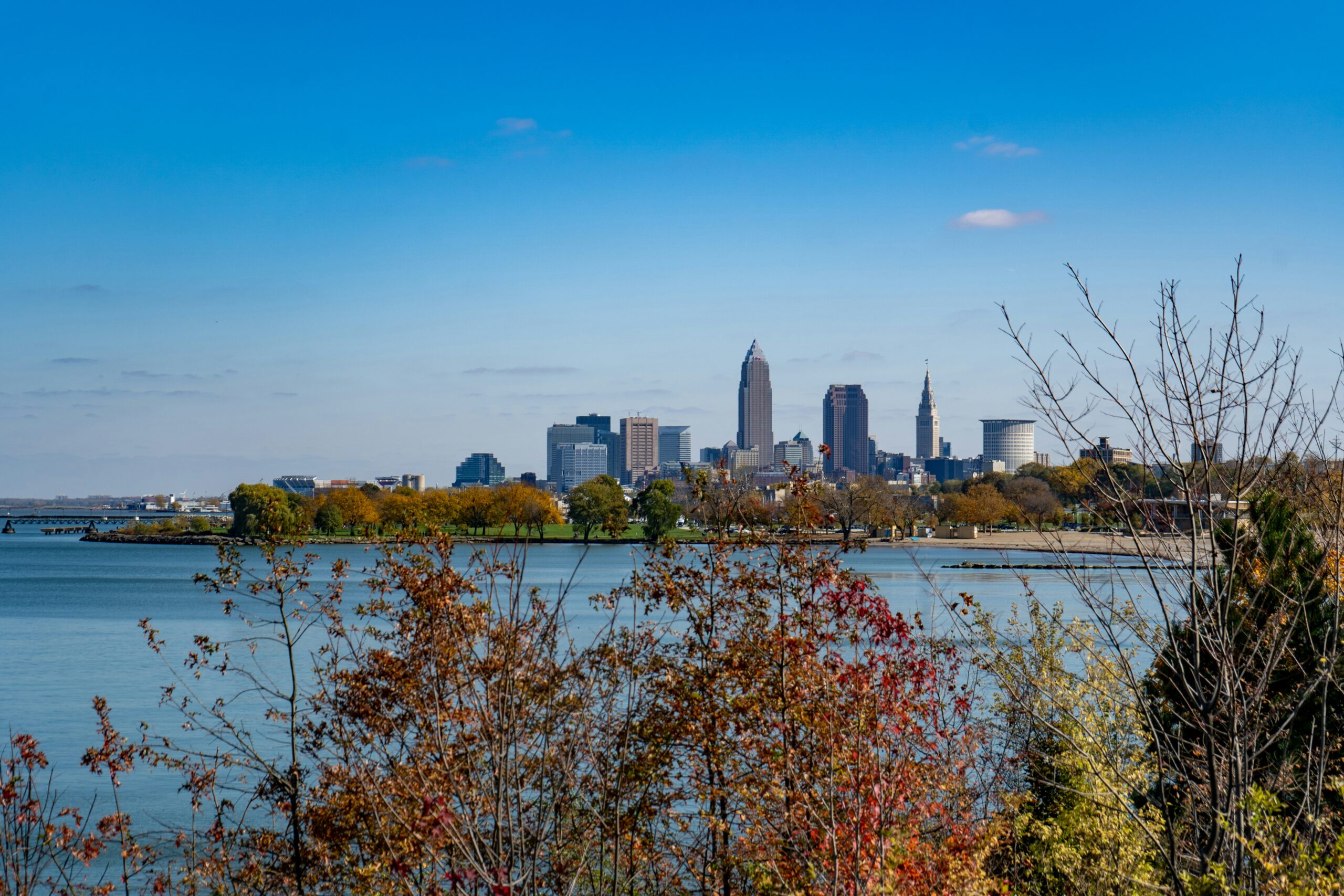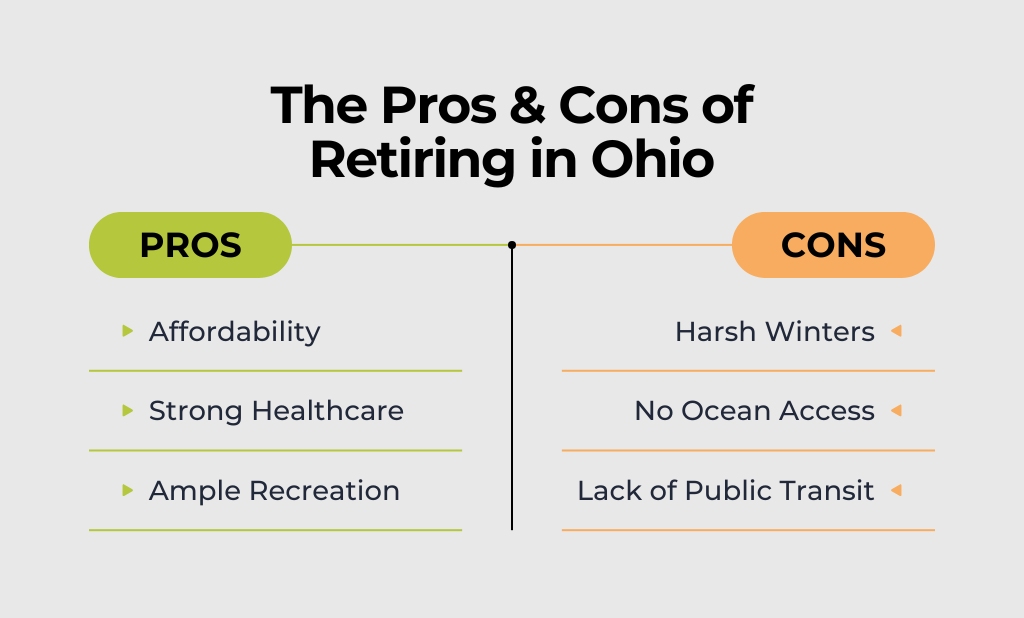Updated: January 7th, 2026
Have you lived in Ohio most of your working life and are debating the question: What are the pros and cons of retiring in Ohio?
Colorful fall weather, a lower cost of living, combined with small-town charm make it a potentially great place to spend your retirement. Cold and grey winters may be less appealing depending on the activities that you enjoy.
If you are looking to make the most of your retirement savings, you may be attracted to Ohio’s major metropolitan areas like Cleveland, Cincinnati, and Columbus. These cities offer many upscale urban amenities at a fraction of the cost of places like New York, Chicago, or Los Angeles.
Article Key Takeaways:
- Ohio’s lower cost of living, affordable housing, and tax-friendly policies for retirees make it a budget-friendly option.
- From top-tier healthcare to scenic parks and recreation, Ohio offers excellent urban and natural attractions to support an active retirement lifestyle.
- Harsh winters, limited coastal destinations, and public transit challenges may pose drawbacks for some retirees seeking year-round sunshine or greater mobility options.
Read on to explore the list of pros and cons about retirement in Ohio to make the most informed decision about your plans.
3 Pros of Retiring in Ohio
When you think about the ideal place to retire, you might picture somewhere with beaches and year-round warm weather. But the Midwest has a lot to offer, and Ohio has some significant advantages for retirees.
Here are three pros of retiring in Ohio:
- Affordable Cost of Living: Ohio’s cost of living is below the national average, which can help your retirement savings go further and support your ideal lifestyle. This means your money can work harder for you, whether you want to travel, start a new hobby, or simply enjoy a comfortable life.
- Strong Healthcare Access: Ohio has a robust healthcare system with many high-quality hospitals and medical facilities. You can have peace of mind knowing you have access to excellent care if and when you need it.
- Ample Recreation Opportunities: From hiking in Hocking Hills to exploring the art scene in Cincinnati, Ohio offers a wide variety of recreational options. Whether you love the outdoors, sports, or cultural activities, there’s always something to do.
Pro #1: Affordable Cost of Living
Ohio’s low cost of living is something you may be very attracted to. This is especially true when you combine the affordable cost of housing with some of the tax benefits for retirees.
| Category | Facts and Figures |
| Cost of Living | Overall cost is 8-12% below the national average |
| Housing | The median home price in Ohio is $259,900 compared to $409,200 nationally (As of November 2025) |
| State & Local Taxes | The state income tax ranges from 0-3.125% and does not apply to Social Security benefits. A flat tax of 2.75% is set to kick in for tax year 2026. |
| Property Taxes | Ohio’s average property tax rate is approximately 1.41%, but this is offset by the state’s low cost of housing. |
| Tax Credits | Seniors in lower income brackets may qualify for some state tax credits. |
| Estate & Inheritance Tax | Ohio’s estate tax was repealed on January 1st, 2013, meaning the state does not impose any additional inheritance tax burdens. |
Low Cost of Housing
According to Forbes, Ohio’s cost of living is currently 8-12% below the national average. As of November 2025, housing is especially affordable with the median home price in Ohio around $259,900, compared to the national median of over $402,900.
As a retiree in Ohio, you will likely be able to find an affordable home and pay off your mortgage quickly. This can help you maximize savings and live debt-free especially if you’ve decided to retire early.
National vs. Ohio Retirement Spending Averages
According to Nasdaq.com and GoBankingRates, the national average retirement household (age 65+) spends around $57,818/yr, or about $5,000/mo. However, in Ohio, the annual cost is a bit lower. The average retirement expenditure for a retiree here is around $53,308/yr.
Here is a breakdown of annual cost averages for an Ohio retiree household compared to the national annual cost:
| Expense Category | Average Ohio Annual Cost | Average U.S. Annual Cost |
| Housing | $9,166 | $11,692 |
| Healthcare | $7,640 | $7,540 |
| Groceries and Food | $4,816 | $4,797 |
| Transportation | $4,745 | $4,943 |
| Utilities | $4,151 | $4,236 |
| Other | $22,790 | $24,610 |
| Total | $53,308 | $57,818 |
Note: The “Other” category includes miscellaneous expenses, insurance, entertainment, and discretionary spending. Source: https://www.nasdaq.com/articles/6-reasons-you-need-least-635k-plus-social-security-retire-ohio
Manageable Taxes
According to SmartAsset, Ohio’s average property tax rate is approximately 1.41%, which is above the national average. The good news is that this rate is offset by Ohio’s low cost of housing.
Ohio’s state income tax which ranges from 0% to 3.125% as of 2025. It’s helpful to know that this tax does not apply to your Social Security benefits, helping you enjoy more of your income. For tax year 2026, Ohio’s income tax is set to drop to a flat 2.75%
According to the Tax Foundation, Ohio has a 5.75% state sales tax. When you include local sales tax in Ohio, the combined state and local sales tax is approximately 7.24%.
As a retiree in Ohio, you will be happy to know that some key items items are exempt from sales tax in Ohio including:
- Groceries (Does not include alcoholic beverages, dietary supplements, soft drinks, or tobacco)
- Prescription Drugs
- Newspapers
Available Tax Credits
Additionally, if you are a senior in a lower income bracket, you may qualify for state tax credits, including the Retirement Income Credit, the Senior Citizen Credit, the Lump Sum Distribution Credit, and the Lump Sum Retirement Credit.
You can read more about these credits and what you need to know about taxes in retirement as an Ohio resident here.
No Estate & Inheritance Tax
According to the Ohio Department of Taxation, the estate tax in Ohio was repealed on January 1, 2013. This means that the state does not create any additional inheritance tax burden to your family when you pass away. Federal estate taxes may still apply for individuals in very high tax brackets.
Pro #2: Strong Healthcare Access
Ohio has some excellent healthcare options, including the prestigious Cleveland Clinic and the Ohio State University Wexner Medical Center, which are consistently ranked among the top hospitals in the United States.
Cleveland also features the top rated University Hospital’s Cleveland Medical Center. It ranks third in Ohio for the best hospitals according to U.S News and World Report.
Cincinnati and Dayton also feature top rated hospitals. These include Christ Hospital and Premier Health Network’s Miami Valley Hospital.
According to Forbes, Ohio overall has a strong national ranking for access to healthcare, making hospital visits and prescription drugs easily available even in smaller towns.
Pro #3: Ample Recreation Opportunities
Dayton, Ohio is particularly known for its expansive trail systems. The city has more than 340 miles of interconnected bikeways, which is the largest network of paved trails in the United States. These trails provide a scenic and accessible way for you to enjoy cycling and maintaining your health during retirement.
Cincinnati, Ohio has approximately 377 parks and has been ranked 5th in the nation for park lands and amenities and features hill covered landscapes that nestle up against the Ohio River.
Cleveland, Ohio is located on the shore of Lake Erie, one of the largest great lakes in the USA, making it an ideal location for those who’ve built fishing and boating into their retirement plan.

Are you a retiree looking for hiking and camping opportunities with scenic waterfalls? You might enjoy exploring Hocking Hills State Park, located near the Appalachian Mountains or the Cuyahoga Valley National Park, near Cleveland and Akron.
If you prefer a bit of adventure in your retirement, be sure to ride the award winning roller coasters at Cedar Point Amusement Park in Sandusky, Ohio and Kings Island Amusement Park in Mason, Ohio.
3 Cons of Retiring in Ohio
It’s important to consider the potential drawbacks of retiring in Ohio to make an informed decision. Every location has its pros and cons, and Ohio is no different.
Here are three potential cons of retiring in Ohio:
- Challenging Winter Weather: Ohio is known for its cold, grey, and snowy winters. If you have any mobility issues or simply prefer year-round warmth, the winter weather may be a major consideration.
- Limited Access to Coastal Destinations: If your dream retirement involves living by the ocean, Ohio may not be the right fit. While Lake Erie and Ohio’s rivers provide a waterfront experience, it’s not the same as an ocean coastline.
- Limited Public Transit: Outside of major cities like Cincinnati, Cleveland, and Columbus, public transportation options exist but are limited. This means you will likely need a car to get around suburbs and country areas and might face challenges if you want to rely on public transit in retirement.
Con #1: Harsh Winters
There’s no getting around it: Ohio has cold, grey, and snowy winters.
The snowfall is magnified due to lake effect in the northern areas of the state, near Lake Erie. The state averages 28 inches of snow annually, and an average January day in Ohio will be likely in the 20s-30s °F temperature range.
Ohio (and most of the midwest) is known for it’s gray and cloudy winter weather. If you prefer sunshine in January and February or aren’t a fan of winter activities, Ohio’s cold climate can be a pretty strong drawback.
Con #2: Limited Access to Coastal Destinations
Ohio’s borders don’t feature ocean access. While Lake Erie provides a waterfront experience, it may not replace the ocean experience if you are seeking a tropical lifestyle.

That said, most of Ohio’s major metropolitan areas including Cleveland, Columbus, and Cincinnati are located on rivers or lakes, providing you with access to water views and boating activities in the warmer months.
Con #3: Lack of Public Transportation
Outside of Cincinnati, Columbus, and Cleveland, public transportation options are limited. According to Policy-Matters-Ohio, the state ranks 33rd in the nation for public transit use and 25 of Ohio’s 88 counties lack a transit system.
City bus services do exist in Cincinnati, Cleveland, and Columbus as well as Ohio’s smaller metropolitan cities, including Dayton, Toledo, and Youngstown, Ohio.
If you can’t drive or live in rural or suburban area of Ohio, you may need to rely on ride shares, friends, and family for transportation.
Best Cities to Retire in Ohio
Despite these challenges, Ohio offers several cities that you should explore as you plan retirement. All of the cities below rank in the 2025 US News and World Reports top 150 cities for retirement:
For a more detailed look at these locations and many others, be sure to check out our recent full blog post, “The Best Places to Retire in Ohio“
Columbus
Ohio’s capital offers a mix of suburban and urban lifestyles with diverse dining, arts, and recreational activities. Columbus is known for its college town atmosphere as the home of The Ohio State University and historic German village.
Cincinnati
With scenic views along the Ohio River and historic architecture, Cincinnati provides a balance between big-city and small-town. Cincinnati hosts three professional sports teams—the Reds, Bengals, and FC Cincinnati—and boasts one of the nation’s top orchestras. Cincinnati also has a strong legacy of craf
Cleveland
Known for its arts scene, proximity to Lake Erie, and top-tier healthcare, Cleveland is ideal for retirees who want both culture and healthcare access. Cleveland is also the home of the Rock and Roll Hall of Fame, the Cleveland Browns, the Cleveland Guardians, and the Cleveland Cavaliers professional sports teams.
Toledo
Also ranked in the 2025 list of top cities for retirement, Toledo is close to Lake Erie, and a short drive from Detroit and Cleveland. Known as the “Glass City” based on its history of glass manufacturing, Toledo is featuring an urban revival. Popular attractions in Toledo include the Toledo Mud Hens Minor League Baseball team, the Toledo Zoo, and the Toledo Museum of Art.
Dayton
Known for affordability, Dayton offers below average property taxes and housing costs, making it appealing to those on a tighter retirement budget. Dayton has a growing downtown core that offers city amenities with plenty of suburban and rural areas nearby. Dayton is also home to the Dayton Dragons minor league baseball franchise.
Youngstown
This affordable town is located near Cleveland and not far from Pittsburgh, PA. Like many rust-belt cities, Youngstown is undergoing an urban revival. It features plenty outdoor activities in the Mill Creek MetroParks. Youngstown is also close in proximity to the popular healthcare facilities in Cleveland.
Considering Ohio for Your Retirement?
Ohio has a great blend of affordability, culture, and small town community for retirees. If you love beautiful fall weather and winter activities, you may thrive as a retiree in Ohio.
While considerations like winter weather and limited public transit may deter you, Ohio’s strong healthcare system, lower cost of living, and recreational options make it definitely worth considering as your retirement home.
As you approach retirement think about whether Ohio aligns with your goals and offers the affordability to stretch your savings.
A Glimpse into Ohio Retirement: The Smith Family’s Story
When John and Susan Smith, a couple in their late 50’s from Dayton, started planning for retirement, they faced the same questions as many of our clients. They had worked hard, saved diligently, and had a nest egg of just over $800,000. Their main goal? To live a comfortable retirement without a lot of flashy spending, maybe travel a bit, and still have their money last.
They considered a move to Florida or Arizona, but after looking at the numbers, they realized their savings wouldn’t go as far. Plus, they wanted to stay close to their grandkids in Ohio. That’s when they decided to re-examine the benefits of staying put.
Life in the Heart of the Midwest
We showed them how Ohio’s lower cost of living and affordable housing would help their savings stretch. They realized they could buy a beautiful home in a great community like Centerville or Springboro for far less than a similar home in a coastal state. The tax advantages were also a huge plus. Because Ohio doesn’t tax Social Security benefits, their monthly income was higher than they had expected, giving them more flexibility to travel and enjoy their hobbies.
Now, imagine a typical week for John and Susan: they spend their mornings at a local coffee shop, then head to the community center for a yoga class. In the afternoons, they might explore a new park or play pickleball. They have peace of mind knowing they have easy access to top-notch healthcare facilities in the Miami Valley. They rely on their car to get around, but with a short 15-20 minute drive, they can get to their favorite stores, restaurants, and doctors’ appointments. Sure, the winters are cold, but they see it as an opportunity to cozy up by the fire or plan a fun trip to a warmer destination. They get to live their ideal lifestyle, right here in the heart of the Midwest, without the worry of outspending their savings.
This is what retirement in Ohio can look like: a comfortable, secure, and fulfilling lifestyle built on smart financial choices.
Frequently Asked Questions (FAQs)
What are the advantages of retiring in Ohio?
Ohio’s main advantages for retirees include a low cost of living, no state tax on Social Security benefits, and a high concentration of quality healthcare facilities. The state also has a wide range of recreational activities and a friendly, community-oriented atmosphere.
What are the disadvantages of retiring in Ohio?
The primary disadvantages of retiring in Ohio are the cold and snowy winters and the limited public transportation options, especially outside of major cities. While the state has a lot to offer, the weather can be a deal-breaker if you prefer year-round warmth.
How much do you need to retire comfortably in Ohio?
While a “comfortable” retirement is subjective, Ohio’s lower cost of living means you can often live well on less than you might need in a more expensive state. For example, the November 2025 median home sales price in Ohio is approximately $259,900 compared to approximately $800,000 in California. For a more personalized answer, a financial planner can help you create a specific plan based on your unique goals and lifestyle.
What is the best place to retire in Ohio?
The “best” place to retire in Ohio is subjective and depends on your personal preferences, but you have many great options across the state. In a recent blog post, we explored some of the most popular areas to help you find a community that fits your ideal retirement lifestyle.
Based on your preferences for lifestyle, culture, and community, you can consider these regions as an example:
- Cincinnati Region: If you prefer to be close to a bustling city, consider areas like Hyde Park, Mount Adams, and Oakley. For a more peaceful, suburban feel, look into Oxford, Blue Ash, and Wyoming.
- Dayton Region: For an urban lifestyle, The Oregon District and St. Anne’s Hill offer a more lively feel. If you prefer a suburban or small-town atmosphere, consider Oakwood, Centerville, and Yellow Springs.
- Cleveland Region: You can find both urban and suburban options here. Tremont and Rocky River are close to the city, while Hudson and Medina offer a quieter, small-town lifestyle.
Ohio is a great state for retirees because it offers affordability, Midwestern charm, a rich culture, natural beauty, and excellent access to healthcare. These factors, along with considerations like cost of living, proximity to family, and community involvement, are helpful when making your decision. For a more detailed look at these locations, be sure to check out our full blog post, “The Best Places to Retire in Ohio”
Is Ohio a good state for retirement?
Ohio offers many benefits, including a lower cost of living and high-quality healthcare, making it a solid option for retirement, though you may find the winter weather challenging.
Do you pay taxes on retirement income in Ohio?
Ohio does not tax Social Security benefits, but other forms of retirement income may be subject to income tax. State income tax credits are available for seniors, especially those in lower income tax brackets.
About the Author

Joseph A. Eck, CFP®, is a financial planner and the owner of Stage Ready Financial Planning, a fee-only RIA based in Dayton, Ohio. As a Certified Financial Planner, Joe specializes in helping retirement savers over 50 who are looking to create their ideal retirement lifestyle. His expertise lies in crafting personalized financial strategies that help clients understand their investments, optimize retirement income, and reduce tax liabilities. He is committed to staying up-to-date on the latest tax laws and regulations to provide his clients with the most informed and effective guidance. Click here to learn more about Joseph.
Article References
- Forbes. (n.d.). Cost of Living Calculator. Retrieved from https://www.forbes.com/advisor/mortgages/real-estate/cost-of-living-calculator/
- Ohio Department of Taxation. (2024). Annual Tax Rates. Retrieved from https://tax.ohio.gov/individual/file-now/annual-tax-rates
- Ohio Department of Taxation. (n.d.). Estate Tax. Retrieved from https://tax.ohio.gov/wps/portal/gov/tax/professional/estate/estate
- SmartAsset. (n.d.). Ohio Property Tax Calculator. Retrieved from https://smartasset.com/taxes/ohio-property-tax-calculator
- Tax Foundation. (n.d.). Ohio Tax Rates & Rankings. Retrieved from https://taxfoundation.org/location/ohio/
- Nasdaq. “6 Reasons You Need at Least $635K (Plus Social Security) To Retire in Ohio.” Accessed October 27, 2025. https://www.nasdaq.com/articles/6-reasons-you-need-least-635k-plus-social-security-retire-ohio
This communication is for informational purposes only and is not intended as tax, accounting or legal advice, as an offer or solicitation of an offer to buy or sell, or as an endorsement of any company, security, fund, or other securities or non-securities offering. This communication should not be relied upon as the sole factor in an investment making decision. Past performance is no indication of future results.

